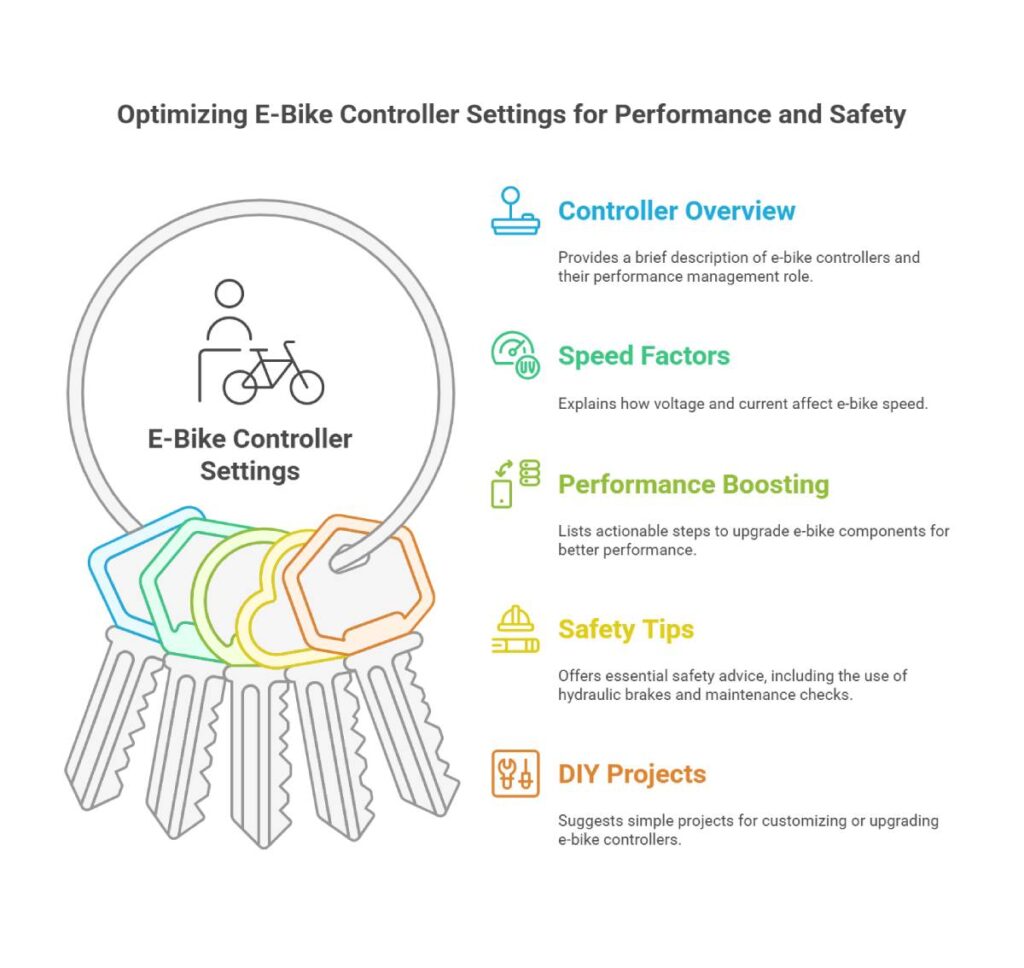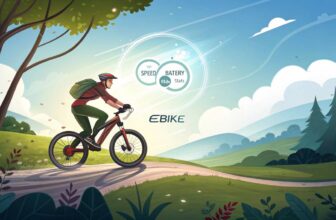Unlock the full potential of your e-bike and transform every ride into an exhilarating adventure! Whether you’re cruising city streets or tackling rugged trails, mastering your e-bike’s controller settings is the key to a smoother, more powerful experience.
Imagine effortlessly gliding up steep hills or extending your battery life with just a few tweaks. In this comprehensive guide, we’ll dive deep into the essentials of e-bike controllers, reveal tips to boost your bike’s performance and ensure your rides are both safe and thrilling.

Ready to elevate your e-bike game? Let’s pedal into the world of enhanced electric biking!
Electric Bike Controller Basics
Getting a handle on electric bike controllers is key to making your ride smoother than a buttered slide. Let’s break down these unsung heroes of the e-bike world.
Understanding EBike Controllers
Think of the e-bike controller as the bike’s chief navigator. It’s the middleman between the battery and the motor, keeping everything running shipshape. The controller ensures you glide off gracefully, balancing your battery’s juice like a circus act and making your pedal-powered pal zoom with zest.
This piece of tech wizardry fiddles with how much power the battery sends to the motor. Kind of like having a DJ for your bike’s power output, it sets the stage for a superb mix of speed and distance (eBikes.ca).
Role of EBike Controllers
The controller’s job is like being a super-efficient post office. It shuttles electricity from the battery to the motor using sensors and smarty-pants algorithms that respond to both your whims and street surprises. Peep these functions:
- Voltage Control: It plays with voltage like a kid with LEGO, stepping it down to keep the motor working right.
- Smooth Acceleration: The controller’s responsible for that silky-smooth start you love—even if you’re trying not to spill your morning coffee.
- Torque and Speed Management: Do you have hills to climb? Controllers team up with the motor to dish out just the power you need. With a beefy 750W brushless hub motor on the Qiolor Tiger e-bike, the controller ensures you’ve got oomph where it counts.
| Function | Description |
|---|---|
| Voltage Control | Tweaks battery voltage to motor level |
| Smooth Acceleration | Keeps your ride smooth as silk |
| Torque Management | Adjusts motor power for all road types |
| Speed Management | Makes sure you don’t rocket out of control |
Knowing your e-bike controller inside out is your ticket to an epic riding experience. Eyeing more insights? Check our piece on ebike classifications. Want the lowdown on motor types? Hit up ebike motor types.
Curious about keeping your e-bike’s heart (the battery) happy and healthy? Our guide on electric bike battery care has you covered. Encounter hiccups with your e-bike controller? Get cracking with our ebike troubleshooting guide—it’s got the scoop on fixing those quirky gremlins.
Factors Influencing EBike Speed
When it comes to juicing up your electric bike, understanding the influences on its speed is the bee’s knees. The spotlight falls on voltage and current—these are the stars of the show when it comes to speed and torque adjustments.
Voltage vs. Speed
Think of voltage as the adrenaline shot for your ebike’s motor. Crank up the voltage, and you’ll see those wheels spin faster, assuming your motor and controller are up to snuff. Say you wanna break free and push your ebike past 25 km/h; boosting the voltage is your ticket (Stack Exchange).
| Voltage (V) | Speed (km/h) |
|---|---|
| 36V | 25 |
| 48V | 32 |
| 60V | 40 |
Bear in mind that overvolting can put your motor in hot water, so always double-check those voltage limits before tinkering. To dig deeper into battery stuff, hop over to our ebike battery voltage page.
Current and Torque
Now, think of the current as the muscle behind your bike’s punch. It’s the main man when you need that extra oomph to conquer steep climbs or take off quicker than a cheetah on Red Bull.
Upgrading the current capability doesn’t make you faster on straightaways in normal conditions, but it ensures you’ve got enough grunt when the going gets tough (Stack Exchange).
| Current (A) | Torque (Nm) |
|---|---|
| 10A | 20 |
| 20A | 40 |
| 30A | 60 |
Be wary that bigger current needs might mean swapping out other parts—like dialing up your battery and controller’s toughness. For a closer look into motor wizardry and performance trickery, take a peek at ebike motor types.
So, wrap your head around how voltage and current do their tango, and you’ll be in the driver’s seat of your ebike journey. Get the lowdown on keeping your battery in tip-top shape by visiting our electric bike battery care section.
Boosting Your EBike Game
Give That Controller a Kick
Swapping out your ebike’s controller is like giving it a little heart upgrade. It’s the mastermind directing all the juice from the battery to the motor and beyond. Picking a snazzier controller can open the door to neat tricks and make everything run smoother.
When you’re ready to upgrade, just make sure the new whiz-bang controller jives well with the motor and battery you’ve got. These upgraded smarty pants controllers often come with extra programming options, letting you fiddle with settings to tweak speed, torque, and that silky smooth ride feel.
What’s in it for you? Here are some sweet perks:
- Zippier Rides: Boosted settings can swap dawdling for dashing.
- Mighty Torque: More oomph means hills and bumpy bits are a breeze.
- Cool New Tricks: Imagine switching ride styles and even having braking that gives the battery a boost.
Want to pimp your ride even more? Check out the DIY fun over in our DIY ebike conversion guide.
Amping Up the Motor
Want your ebike to strut its stuff? Dialing up the motor’s power might just be your jam. The motor vibes depend on volts and amps, so getting to know these is your ticket to supersonic upgrades.
Voltage: The Need for Speed
Revving up voltage is like rocket fuel for speed. More volts means more zip, but it also means your motor-controller duo needs to handle the heat. Upgrading might mean an all-out overhaul to keep the peace between the battery and the motor. Don’t miss a beat, though—have a peek at how volts make the wheels turn faster.
| Voltage | Speed Gains |
|---|---|
| 36V | Your starter speed |
| 48V | About 20% more zip |
| 52V | A whopping 30% speed boost |
Current: Torque Galore
Current’s your buddy for torque. More amps let your motor pack a punch on hills and zip off the line. Cranking up current means giving your controller a bit of a makeover. A cheeky mod—like adding solder to the shunt—can nudge up the amps, bringing torque and speed along for the ride.
Check out our deep dives on ebike battery voltage and torque vs cadence for the inside scoop.
Other nifty bits to think about when dialing up power:
- Be Pals with Compatibility: Your motor and other bits need to play nice with extra volts and amps.
- Keep a Cool Head: More power equals more heat. You might need some extra fans or doodads.
- Play by the Rules: Give a once-over to electric bike laws ’cause extra power might not be street legal everywhere.
With these tweaks, your ebike will go from meh to magnificent—faster, stronger, and way more fun. Hungry for more know-how? Swing by our ebike troubleshooting guide for a treasure trove of tips and tricks.
Keeping Your EBike Safe and Sound
Riding an electric bike can be a joy, but let’s not forget the importance of hitting those brakes just right—hydraulic brakes are your best bet for keeping everything under control on your trusty two-wheeler.
Why Hydraulic Brakes Matter
Hydraulic disc brakes aren’t just fancy words—they pack a punch when it comes to stopping power and reliability. These brakes operate using pressurized fluid, meaning they’re like the superheroes of bikes, handling tough conditions without breaking a sweat (Himiway).
Here’s why you’d wanna have these bad boys on your ride:
- Stopping Power Like a Champ: The force you get here will stop you on a dime.
- Smooth Operator: They give you that seamless, smooth stop every time.
- Keeps It Cool: Handles heat like a pro, so no slacking off even during long descents.
- Low Fuss Maintenance: Less tinkering compared to those old-school mechanical brakes.
- Rain or Shine: Reliable performance no matter the weather.
Wanna get the full scoop? Don’t miss out on our extensive guide to electric bike brakes.
Picking Your Brake System Wisely
Choosing that perfect brake system isn’t just about stopping; it’s about having peace of mind. Here are some things that really count:
- Motor Cutoff Switch: Cuts out the motor when you hit the brakes—a lifesaver!
- Quick Stop: Bringing your bike to a smooth halt is what it’s all about.
- Control and Feel: It’s all about how you can finesse that braking force.
- Handles the Heat: Heat efficiency stops brake fade—especially going downhill.
- Easy on the Upkeep: Check how often you need to check under the hood.
- Fitting Right In: Make sure your brakes are a fit for your bike’s setup.
Keep your hydraulic brakes in peak condition with these tips:
- Wipe It Down: Keep ’em clean and dry so dirt doesn’t gunk up your stops.
- Pad Check: Keep an eye on pads; change ’em when they’re looking thin.
- Bleed ‘Em Out: Remove any air from the system now and then—keep it solid.
- Look Over Parts: Catch any damage early by checking pistons, hoses, and so on.
For a whole lot more advice on keeping your ride joyful and safe, check out our electric bike maintenance and ebike safety features guides.
| Brake Thoughts | Why It Matters |
|---|---|
| Motor Cutoff Switch | It’s all about safety peace of mind |
| Stopping Like a Pro | Makes sure the brakes gel with your e-bike |
| Control Your Style | Perfectly applies the force you need |
| Handles the Burn | Cuts down on brake fade, no sweat |
| Easy-Peasy Maintenance | Keeps your brakes tip-top with minimal fuss |
| On-Spot Fit | Make sure the brakes gel with your e-bike |
Making your ride as safe as possible means picking a rock-solid braking system. Whether you’re commuting, working on that fitness game, or just out for the breeze, knowing how to maintain your brakes doesn’t just add years to your bike—it could add years to you!
DIY EBike Controller Projects
Got a knack for tinkering and a love for bikes? Say hello to DIY ebike controllers! This guide’s got your back as you take on building a custom ebike controller. Whether you love challenges or just want to understand what sparks the magic in ebikes, let’s get cranking!
Building a Custom Controller
Sure, building one might sound tough, but it’s as doable as riding a bike with a bit of help. The EBike/EScooter motor controller is designed to be a DIY haven. With its easy repair and build inspo, it fits the bill for weekend warriors and tech enthusiasts alike.
Steps to Build:
1. Round Up Your Parts:
- Tiny resistors (0805)
- Small ICs like SOIC8 and SOIC14
- Extras: fancy things like CAN comms, UARTs, torque sensor circuits, OLED display connections, and even Bluetooth if you’re fancy
2. Prepare Your Circuit Board: Design or snag a slick PCB template that’s ready to handle these components like a boss and has a few spots for bonus electronics.
3. Solder Like a Pro: Steady hands, folks. Solder those pint-sized resistors and IC chips onto the board. Patience will be your best friend here.
4. Choose Your Brain: Debate between the power-hungry Blackpill board for major processing or the straightforward Bluepill for simple setups.
5. Upload the Brainpower: Load up with open-source firmware crafted over five years. It’s your all-access pass to shape functions like torque check and Bluetooth flair.
Controller Circuit Components
Peek under the hood at these vital components. They’re the secret sauce in your ebike controller mix.
| Component | Description | Function |
|---|---|---|
| Microcontroller | Blackpill or Bluepill board | The brain, making all the smart stuff happen |
| Resistors | 0805 resistors | Keeps the electricity flowing right |
| Integrated Circuits (ICs) | SOIC8, SOIC14 | Handles voltages and signals |
| Headers | Custom electronics board | Adds new tricks, like different connections |
| Connectors | USB C or the like | Powers up and transfers data |
Show some love to the SimpleFOC Community for detailed breakdowns!
Why Each Piece Counts:
- Microcontroller: It’s the operation hub, pulling the strings.
- Resistors & ICs: Keeping the current and voltage in check so nothing fries.
- Headers & Connectors: When you want to tweak and add tricks to your ride.
Cracking these gizmos open lets you turbocharge your bike’s heart and soul. If that urges you to grab the toolkit, our DIY ebike conversion piece is brimming with more golden nuggets.
Got controller blues or just tweaking queries? Our ebike troubleshooting section’s got your back. Don’t miss it for insights and ways to keep your e-wheels rolling smoothly.
Resetting and Troubleshooting
Taming those “ebike controller settings” is crucial for smooth rides. Let’s jump into how to hit reset on your e-bike controller and tackle those nagging glitches.
How to Reset an Ebike Controller
Do some funky speed blips, power hiccups, or mysterious error codes popping up? Resetting your e-bike controller can often work wonders, clearing up temporary hiccups and getting your ride back to its best performance.
Steps to Reset
- Turn It Off: Make sure your e-bike is completely off.
- Yank Out the Battery: Take that battery out to reset the brain.
- Chill for 5-10 Minutes: Let everything power down and discharge.
- Plug the Battery Back In: Reattach securely to make sure everything clicks.
- Fire It Up: Turn on your e-bike and give it a whirl to see if things are sorted out.
It’s best to keep the resets to a minimum—once or twice a year should do it unless you’re wrestling with constant tech troubles. Extreme situations might demand more frequent resets. Always peek at your bike’s manual, and if things are still off-kilter, it might be time to ring up the bike folks for some help.
Troubleshooting Tips
Did you get annoyed with the e-bike controller? Let’s hash out some ways to zero in on the problem and fix it.
Check Connections
- Tighten Up: Make sure all plugs and wires are snug as a bug in a rug—no loosey-goosey or frayed bits.
- Avoid Danglers: Check for any loose or hanging wires—they can mess with how the controller does its thing.
Inspect and Test the Battery
- Charge It Up: Is the battery juiced up? A low battery can throw things off.
- Battery A-OK: Double-check the battery’s health to see if it’s causing the issues. Keep up with battery TLC as per electric bike battery care.
Firmware and Software Updates
- Look for Updates: Is there any new firmware for your controller? Updates can squash bugs and boost things up.
- Follow the Manual: Always stick to the manufacturer’s instructions for updating safely.
Consult Your User Manual
- Decode Error Codes: Spotting error codes? Your manual’s got the lowdown on those and how to tackle each one.
Call in the Pros
- Get Expert Help: If all else fails, don’t hesitate to bring in the big guns. Services like electric bike maintenance can sort out the tricky stuff.
By handling these resetting and troubleshooting tips, you’ll keep your e-bike running like a dream. For more in-depth advice on e-bike fixes, head over to our ebike troubleshooting section.
Controller Repair and Maintenance
Keeping your electric bike’s brain—the controller—working smoothly helps you zip around safely and optimally. This section serves as handy tips to pamper your ebike controller and tackle those pesky problems you might encounter.
Controller Care Tips
Treat your electric bike controller right, and it’ll return the favor by lasting longer and working better. Here are some words of wisdom:
- Peek and Poke: Give the controller a regular once-over. Spotting wear, corrosion, or those tell-tale signs of damage early on can mean the difference between a quick fix and a wallet-emptying disaster.
- Clean the Grit: Make sure electrical connections stay spick and span. Gunk and grime can mess with your ride’s mojo, so keep them at bay.
- Dry ‘n’ Happy: Water and electricity aren’t the best of friends. Shield your controller from the wet stuff. Think about sprucing up your ebike’s raincoat if you regularly take it out in stormy weather.
- Cool it, Seriously: Controllers can get hot under the collar if there’s no breeze. Ensure they catch some air, especially when you’re pushing the pedal to the metal for long stretches.
- Stay Current: Firmware updates are like power-ups for your controller. They fix bugs and can make your ride purr better. Check in with the maker now and then for the latest scoop.
Common Issues and Solutions
Finding out what’s giving your ebike attitude can save cash and keep you rolling. Here’s a rundown of common controller kerfuffles and how to fix them:
| Issue | Possible Cause | How to Fix It |
|---|---|---|
| No Juice | Battery connections are on the fritz | Tighten them up, and make sure your battery’s got some zing. |
| Power Outages | Bad cables or connectors playing hide and seek | Vent out some heat and double-check that the controller’s playmate, the motor, is the right fit. |
| Crazy Motor Moves | Throttle or brake issues acting up | Check that the throttle and brakes are behaving. |
| Hot Headed | Needs air, or maybe gulping too much juice | Vent out some heat and double-check the controller’s playmate, the motor, is the right fit. |
| Mystery Codes | Internal mysteries call for help | Your user manual can decode these cryptic messages. Call in the experts if you’re still scratching your head. |
Sometimes, giving the ebike controller a reset can smooth out those unexpected snags. This typically means having a look over connections, juicing up the battery, and poking into firmware updates. For the nitty-gritty on how to pamper your ebike, mosey on over to our guide on troubleshooting ebike quirks.
By showing your ebike controller some love and attention, you’re on the fast track to happy and safe rides. Craving more on keeping your ride in tip-top shape? Check out our piece on caring for your electric buddy.
Exploring EBike Motors
Getting the hang of the motor on your electric bike can make all the difference in your ride. We’re taking a closer look at ebike motors, focusing on what makes mid-drive and hub-drive motors tick and how they stack up against each other.
Motor Power and Performance
When we talk ebike motors, we’re really talking watts. That’s how power is measured—either continuous or peak. Continuous power is like your motor’s comfort zone, which it can handle consistently. Peak power is the upper limit it hits during those short, adrenaline-pumping moments.
Take the EVELO Delta X, for instance. It cruises comfortably at 750 watts but can push up to 1,000 watts when you need that extra oomph.
| Motor Type | Continuous Power (W) | Peak Power (W) |
|---|---|---|
| EVELO Delta X | 750 | 1,000 |
| Average Hub | 500 | 750 |
| Average Mid | 350 | 500 |
But, watts aren’t everything. How the motor pairs up with the controller and battery really sets the stage. Think about it like this—sometimes a mid-drive motor pumping out 350 watts can outperform a hub-drive boasting 500 watts, depending on the ride. It’s all about how well the motor’s muscles are flexed and coordinated.
Mid-Drive vs. Hub-Drive Motors
So, what’s the scoop on mid-drive versus hub-drive motors?
| Feature | Mid-Drive Motors | Hub-Drive Motors |
|---|---|---|
| Position | Near the bike’s belly button (bottom bracket) | Part of the wheel gang (in the hub) |
| Power Efficiency | Climb those hills like a champ | Made for cruising the flatlands |
| Weight Distribution | Keeps the bike zen-balanced | Weight at the ends, which changes the handling |
| Maintenance | Needs more TLC | Low-maintenance and chill |
| Performance | Packs a punch with torque | Smooth operator’s smooth territory |
| Cost | Puts a dent in the wallet | Easy on the budget |
Mid-Drive Motors
Mid-drive motors are like having a spring in your step placed right near the pedals. They offer a great balance advantage and transfer power efficiently. These motors shine when it’s time to tackle steep slopes. Thanks to torque sensors that sync with your pedal power, you’re always getting just the right boost.
Riders who want performance and flexibility might want to pay attention here. While a bit on the pricey side and requiring more upkeep, the power and efficiency gains make them worth considering for hustle-bustle city riders or those tackling hills on the regular.
Hub-Drive Motors
Hub-drive motors are mounted right on the front or back wheels, offering steady power. Typically friendlier on the wallet than mid-drives, they’re simple and easy to maintain.
Perfect for flat roads and day-to-day city riding, hub drives offer a quiet, smooth journey. Sure, the weight distribution is a bit different, and that changes how your bike handles, but for an easy-ride and budget-friendly option, it’s a solid pick.
Figuring out the power and tribulations of these motors can really sharpen your ebike know-how. Whether you’re eyeing torque and efficiency or you’re more about easy-going and affordable, cracking the motor code will level up your ebike game. For more juicy details on ebike motors, swing by our ebike motor guide.
EBike Battery Considerations
Wrapping your head around ebike batteries takes your ride from blah to wow and ensures you get the most outta your two-wheel electric buddy. Let’s chew on the biggies: what battery voltage means and why those amp-hours matter.
Battery Voltage Impact
Voltage ain’t just tech babble—it’s the muscle in your ebike’s engine. Think of a 48V battery like a superhero compared to a 36V sidekick. More volts equal more ‘vroom’ for climbing nasty hills or zooming like the wind. Want more juice on battery voltage? Cruise over to ebike battery voltage for the full scoop.
| Battery Voltage (V) | Power Output | Best Use |
|---|---|---|
| 36V | Moderate | Flat terrain |
| 48V | High | Steep hills, higher speeds |
Amp-Hours and Range
Amp-hours, or Ah for the cool kids, show off your battery’s stamina. It’s basically the size of your ebike’s lunchbox—the bigger, the longer the ride without hangry stops for juice. Bigger Ah means further travel per charge, but the landscape plays a huge game too – hills, your weight (yes, you gotta count that burrito in), and how much you pedal also decide the distance.
| Battery Capacity (Ah) | Estimated Range (miles) |
|---|---|
| 10Ah | 20 – 35 miles |
| 15Ah | 30 – 50 miles |
Our pals at EVELO put these figures together if you’re curious about cruising distances.
Hungry for detail on amp-hours’ role in your ebike spin? Check our ebike range factors guide.
For tips on keeping your battery happy and healthy, roll over to electric bike battery care. And if you’re wondering how to handle an ebike juicing session like a pro, peek at our how to charge ebike page.
Nailing the voltage and amp-hour game means happier city jumps, greener choices, and weekend rides that’ll turn heads.
Conclusion
Enhancing your e-bike with optimized controller settings isn’t just about speed—it’s about crafting a personalized and reliable riding experience tailored to your unique needs.
By understanding the intricate role of e-bike controllers, you can fine-tune your bike’s performance, ensuring smooth acceleration, efficient power management, and robust torque for conquering any terrain.
Upgrading components like controllers and motors opens up a world of customization, allowing you to adjust settings for speed, torque, and ride comfort. Safety remains paramount; investing in hydraulic brakes and maintaining your e-bike diligently ensures every journey is secure and enjoyable.
For the hands-on enthusiasts, DIY controller projects offer a rewarding way to deepen your technical knowledge and customize your ride further. Regular troubleshooting and maintenance not only prolong the lifespan of your e-bike but also keep it performing at its peak.
Embracing these strategies transforms your e-bike from a simple mode of transport into a powerful, versatile companion for all your adventures.
Dive into our additional resources and guides to continue elevating your e-bike experience—because every ride should be as extraordinary as you are.
FAQs
What is an e-bike controller and why is it important?
An e-bike controller is a central hub that manages power flow between the battery and motor. It ensures smooth acceleration, regulates speed, and maintains optimal performance, making your ride more efficient and enjoyable.
How can I increase my e-bike’s speed safely?
You can increase your e-bike’s speed by adjusting the voltage settings in the controller, upgrading to a more powerful motor, or enhancing your battery capacity. Always ensure compatibility and adhere to local regulations to maintain safety.
What are the benefits of hydraulic brakes on an e-bike?
Hydraulic brakes offer superior stopping power, smoother operation, and better performance in various weather conditions. They require less maintenance compared to mechanical brakes, providing reliable safety for your rides.
Can I build a custom e-bike controller myself?
Yes, with the right tools and knowledge, you can build a custom e-bike controller. DIY projects allow for personalized settings and a deeper understanding of your bike’s mechanics, but ensure you follow detailed guides and safety precautions.
How often should I perform maintenance on my e-bike controller?
Regular maintenance, such as cleaning connections and checking for wear, should be performed monthly. Additionally, firmware updates and thorough inspections should be done every few months to ensure optimal performance and longevity.
Final Thoughts
Optimizing your e-bike’s controller settings is a game-changer that can elevate every aspect of your riding experience. From achieving smoother acceleration and enhanced torque to ensuring your bike’s safety with reliable braking systems, these adjustments empower you to tailor your e-bike to your specific needs and riding style.
Embracing upgrades and DIY projects not only boosts performance but also deepens your connection with your bike, making each ride more enjoyable and personalized.
Remember, regular maintenance and understanding the intricate balance between voltage and current are essential for sustaining your e-bike’s longevity and efficiency. At MyBikeReview.com, we’re committed to providing you with the insights and resources you need to make informed decisions and keep your e-bike in peak condition.
Dive into our comprehensive guides, explore our recommended products, and join our community of passionate e-bike enthusiasts.
Your journey to a superior and exhilarating electric biking experience starts now!
Key Tips Around the Bike Topic
- Regular Maintenance: Keep your controller and motor clean and dry to prevent malfunctions.
- Firmware Updates: Always check for and install the latest firmware to ensure optimal performance and security.
- Proper Installation: When upgrading components, ensure compatibility to avoid electrical issues.
- Safety First: Invest in quality brakes and perform regular safety checks to ensure reliable stopping power.
- Battery Care: Maintain your battery by charging it properly and avoiding extreme temperatures to extend its lifespan.
- DIY Caution: Follow detailed guides and take necessary safety precautions when undertaking DIY projects.
- Monitor Performance: Keep an eye on your e-bike’s performance metrics to identify and address any issues early.
Recommended Biking Products and Accessories
- Upgraded E-Bike Controller
- Brand X High-Performance Controller – Enhance power management and customization options.
- Hydraulic Brake Kit
- BrakeMaster Pro Hydraulic Brakes – Superior stopping power and reliability in all conditions.
- High-Capacity Battery Pack
- PowerPlus 48V 15Ah Battery – Extend your ride range with increased amp-hours.
- Torque Sensor
- TorqueMaster Sensor – Improve pedal-assist accuracy and ride responsiveness.
- LED Display Panel
- BrightView LED Display – Monitor speed, battery life, and other vital stats in real-time.
- Bluetooth Module for Controllers
- SmartConnect Bluetooth Module – Enable wireless control and firmware updates for your e-bike.
- E-Bike Maintenance Toolkit
- BikeCare Complete Toolkit – Essential tools for regular maintenance and DIY projects.
- Weatherproof Controller Cover
- DryGuard Controller Cover – Protect your controller from rain and dust for extended longevity.
- Performance Motor Upgrade
- TurboBoost 750W Brushless Motor – Increase your e-bike’s torque and speed capabilities.
- E-Bike LED Lighting Kit
- LightUp Pro Kit – Enhance visibility and safety with bright, durable LED lights.
These products are selected to help you optimize your e-bike’s performance, ensure safety, and customize your riding experience to match your personal preferences and needs.




